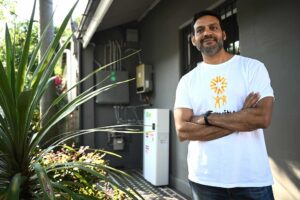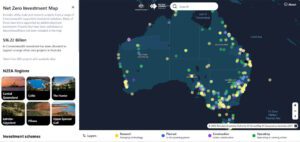Fortescue Future Industries, the company leading iron ore billionaire Andrew Forrest’s ambitious green energy transition plans, has suggested that Australia is more likely to follow a “hydrogen superpower” scenario that would see the end of coal generation within a decade.
In a submission to the Australian Energy Market Operator’s draft 2022 Integrated System Plan, Fortescue applauds the market operator’s work to define a “step change” scenario that will usher in a rapid transition to renewables over the next decade or two.
But Fortescue believes it will go quicker than that, and that “step change” will be quickly superseded – possibly as early as the 2024 ISP – by the “hydrogen superpower” scenario that models the end of all coal generation in Australia by 2032, and is the only scenario consistent with 1.5°C.
“It is an important step forward for the ISP to account for scenarios that continue Australia’s economic strength as we transition away from a fossil-based economy,” Fortescue says in its submission.
“With this in mind, we would suggest that over time, the hydrogen superpower may prove more likely, similar to how the step change scenario has replaced the central scenario in this ISP. In fact, it is increasingly likely that at least a few large projects will be well-underway by the time the 2024 ISP is released.”
Fortescue’s position contrasts sharply with the main legacy fossil fuel utilities in Australia, who argue that the transition cannot happen as quickly as AEMO models.
AGL, in particular, refuses to believe Australia can move that fast and has brought forward its planned closure date of the Loy Yang generator in Victoria to just 2045, some 13 years after the modelled closure of all brown coal generators in AEMO’s “step change” scenario.
Origin, in its submission, says there is a “disconnect” between AEMO’s modelling and “what is reasonably practical”. Delta Energy, which owns the Vales Point coal generator, was also highly critical of the forecasts of early coal closures and its potential impact on grid security and reliability.
The main question for many centres on how quickly can new transmission links be built, and the ability to then connect and commission sufficient quantities of wind, solar and various forms of storage, including batteries and pumped hydro.
Fortescue, however, says it and its competitors are working to timescales that align more closely with early large scale hydrogen commencing operation from the mid-2020s, and the industry becoming well established by 2030.
“This is in contrast to the slower uptake projected in the Hydrogen Superpower scenario,” it says. “We would be pleased to provide a confidential briefing to the AEMO ISP team on FFIs project plans to better inform the hydrogen superpower scenario ahead of the 2024 ISP development.”
So far, Fortescue has revealed a number of MOUs for concept plans, and some technology deals, but it also expects to begin construction on its first electrolyser factory soon and recently unveiled plans for a 5.4GW wind and solar project in the Pilbara, backed by more than 9GWh of battery storage.
Fortescue says that AEMO may need to reconsider its transmission and storage forecasts in light of a massive investment in flexible hydrogen electrolysers.
“Once the system reaches high penetrations of zero marginal cost renewable energy, and the opportunity costs for electrolyser flexibility reduce, we may begin to see GW scale electrolyser facilities being used to balance the system and provide system services such as frequency response,” it says.
“While this will be a useful tool for AEMO to manage the system, the impact on shorter-term storage investment may need to be considered through the ISP as this may have an impact on revenues these technologies can achieve.”
Similarly, the impact on the need for transmission developments may change as a result of massive load growth in certain areas.
“The development of these GW scale load centres will be highly resource and infrastructure location dependent limiting the ability to locate them in areas that most benefit the grid.
“Huge load growth in certain states may influence the transmission planning required to support reliability in those and neighbouring states. AEMO will need to be aware of these projects as soon as possible to ensure they are considered well in advance in planning documents like the ISP.”
Meanwhile, at its half-year results announcement on Wednesday, Fortescue came under pressure from journalists and analysts, alike, to firm up the details – in particular on timing and cost – around its green hydrogen and renewable energy plans.
Fortescue reported a record half year of iron-ore shipments and a net profit after tax of $US2.8 billion – the third highest in the company’s history, according to outgoing CEO Elizabeth Gaines.
But it also trimmed interim dividends for the period to 88c per share, a more than 40% cut on the $1.47 at the same time last year.
Whether this made analysts nervous, and financial journalist suspicious, the questions in the media and analyst briefings after the results announcement sought evidence of progress made on FFI’s seemingly endless series of project announcements and how they will be costed and paid for.
Questions focused in particular on the progress of the proposed Global Green Energy Manufacturing Centre in Gladstone, the Christmas Creek hydrogen refueling station, and the massive 5.4GW Uaroo Renewable Energy Hub announced at the end of last week.
So what did Fortescue have to say?
Green Energy Manufacturing Centre in Gladstone:
“We’re absolutely on track,” Gaines told analysts. “We’ve got the approvals that we needed, we’re turning ground, construction is commencing and our plan is still for production of electrolysers in early 2023. So no change to our plans there.
“That initial phase was up to 2GW for $83 million investment. The broader phase is the expansion of the manufacturing capabilities which may include wind turbines and other other aspects of renewable energy. But the focus at the moment is on the development of the manufacturing facility.”
Christmas Creek green hydrogen mobility project:
“The majority the buses have arrived, we’re still constructing and we took the opportunity to look at optimising that refuelling infrastructure and generating hydrogen on site from renewable energy – that is still going ahead; it’s more towards the second half of this year,” Gaines said.
“[We’re just] making sure we optimise that opportunity because as we’re advancing our views on green hydrogen, and using our mobile fleet, we want to make sure we can optimise that, not only for those buses and coaches, but also … as we look to to fully decarbonise our mining fleet.”
Uaroo Renewable Energy Hub:
“The [5.4GW proposal] has gone to a public consultation, prior to submission to the EPA, but it is in that study phase, and the timing of development and ultimate project investment will be determined by detailed studies,” Gaines said.








